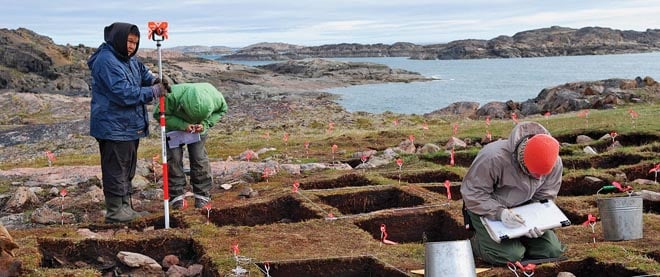Vikings in Canada?
A researcher says she’s found evidence that Norse sailors may have settled in Canada’s Arctic. Others aren’t so sure.
Patricia Sutherland
Share

If Patricia Sutherland’s hunch was right, she was staring at evidence that could rewrite the early chapters of Canadian history books. It was a piece of incredibly old cord, dug up on Baffin Island in the eastern Arctic. The year was 1999, and something about the cord’s texture gave her pause.
It didn’t look like other indigenous artifacts unearthed in the Arctic. It looked European, like the spun yarn she’d once seen on a medieval Norse farm in Greenland. If the cord, several metres in length, was indeed Old World technology, it meant that Vikings may have settled in Canada’s eastern Arctic as early as 1000 CE, hundreds of years before Samuel de Champlain’s fur-trading exploits.
Sutherland, then an archaeologist with the Canadian Museum of Civilization in Gatineau, Que., sent a piece of the cord to a Norse textile expert in England to examine. The answer? The material was indeed comparable to spun yarn from 14th-century Greenland.
So launched a 13-year odyssey to sift through hundreds of artifacts in existing Arctic collections that has sent Sutherland back to the Arctic several times in search of more clues of a Norse presence there.
Sutherland’s findings have sparked international media interest. But controversy has dogged the soft-spoken 63-year-old researcher. Earlier this year, the museum let her go, though the circumstances of her departure remain unclear. Meanwhile, her sudden popularity—National Geographic profiled her work this month, and an upcoming episode of CBC’s The Nature of Things will also focus on her research—has sparked complaints from academic critics who say she hasn’t proved her case.
Ever since archaeologists discovered a Viking outpost in 1960 near L’Anse aux Meadows in Newfoundland’s north, others have scoured the eastern seaboard for clues that Norse seafarers pushed deeper into Canada.
Sutherland thinks Norse sailors made friendly contact with the Arctic’s Dorset hunters who roamed the region until the 15th century. The Norse wanted walrus ivory and furs, prized in Europe. The indigenous hunters needed metal and wood.
There were other clues. Sutherland and her team identified whetstones used to sharpen metal tools, finding traces of bronze and smelted metal on the rocks. Ancient Aboriginal people “weren’t smelting iron,” she notes. And the team identified notched wooden sticks similar to the tally sticks the Norse used elsewhere to record trade transactions.
Sutherland’s theory paints the ancient Arctic in a whole new light, casting the frozen North as a hub of commercial trade.
“The Arctic was not this isolated, marginal place as is often assumed,” says Sutherland. “In the centuries around 1000 CE, it was really a nexus for the people from the Old World meeting with people from the New [World]. The picture that is coming out of the work we’re doing is that trade was taking place much earlier than the fur trade and the time of Champlain. We’re beginning to find what could be interpreted as the beginning of early globalization.”
Not all Arctic experts are convinced Sutherland has proved her theory. William Fitzhugh, the director of the Arctic studies centre at the Smithsonian Institution in Washington, says Sutherland’s idea is intriguing, but apart from a 2009 paper, she hasn’t published enough. “So there are a lot of tantalizing statements made that are not backed up by evidence . . . and this is kind of typical,” Fitzhugh says. “The fact is, we’d just like to see more responsible publication of information before you run off to the press and make a lot of claims that attract a lot of attention but aren’t resolved.”
In fact, Fitzhugh thinks the cord at the centre of Sutherland’s “eureka” moment is a Dorset artifact. “We have very good evidence that this kind of spun cordage was being used hundreds of years before the Norse arrived in the New World, in other words 500 to 600 CE, at the least,” he says.
Earlier this year, when the museum let Sutherland go, it effectively cut her off from her research files. Neither Sutherland nor the museum will say why she was terminated, though she’s hinted that political forces were at play.
Sutherland’s supporters—including James Tuck, a professor emeritus of archaeology at Newfoundland’s Memorial University—speculated that her revised Canadian narrative might not jibe with the museum’s new mandate. Indeed, the Conservative government has announced plans to change the name of the museum to the Canadian Museum of History, with a new focus on showcasing prominent historical figures.
“There is some jealousy,” Tuck says, referring to Sutherland’s critics. He thinks her research, though still a work-in-progress, is promising. “It’s certainly become more and more convincing over the last decade,” he says. “I don’t think the case is 100 per cent proven, but then nothing is in archaeology or anthropology.”
Sutherland says she expected skeptics, but was dismayed at their “negativity.” “Anything new is controversial in science. And anything new is subject to scrutiny.”
For its part, the museum says it hasn’t blocked Sutherland. Its vice-president of public affairs, Chantal Schryer, said the museum is negotiating with the archaeologist about gaining access to the research materials and her files. Some artifacts may be returned to Nunavut. Schryer also denied that Sutherland’s new take on Canada’s Arctic didn’t fit with the museum’s changed mandate. “This is complete nonsense,” she says. “The museum continues to be interested in the Arctic.”
Sutherland wants the issue resolved. She needs access to her research files to publish her latest findings, which, at the very least, would allow her to take on her skeptics. “I’ve spent 13 years working on this project,” she says. “We want to do more work and we want to be able to bring this new knowledge to the people of Canada.”